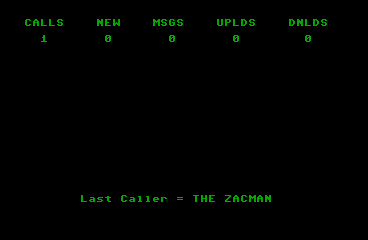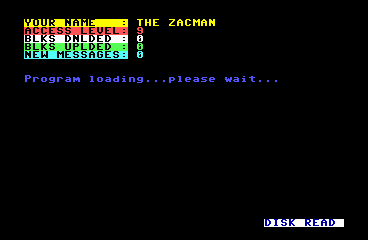
Color 64 holds a very special place in Commodore BBS program history as the software which truely began the effort to show the potential in our systems for color/graphics, online movies, background changes, etc. Before Color 64, although there were some color BBSs out there, none were very polished or allowed graphics use very easily. Color 64 did all this while still maintaining the level of capability and sophistication we've come to expect from our software.
Moreover, Color 64 is unique. From its famous cycle of colors on all text strings to the really cool prompts, the keystroke logs that added so much to SysOping, the ability to save cursor movements and other fancy characters without entering codes or worrying about it coming out differently when being read; Color 64 simply did things others refused to do, and did it with definite style.

About the only uncolorful part of the system is the waiting for call screen.
Color 64, however, loaded modules. The length of these modules and the sheer sucking of online time they entailed was enough to drive many SysOps either crazy, or outright AWAY from this software. The following screen shows a message many users sat patiently through...

Immediately after logging on, one waited seeming hours for the first module to load.
The information below pertains to Color 64 v7.37, the last official version of the system, which is now freeware. I compiled the information based on documentation from the Color 64 home page, and from what I recall of the systems I've seen. If any information here needs to be changed or updated, please let me know.
Computer : Commodore 64 or 128 in 64 mode Video : 40 columns Drives : Commodore drives, full CMD support, REU support Modems : 1650, 1660, 1670, Hayes, RS232, 100 - 2400 baud Input : Keyboard Output : Printer RAM use : As a swap area for system modules Special : 1571 flippy support
Pgm Struct : Large overlayed modules Menu Struct : Text changable, hotkey system Translation : ASCII, PETSCII Access : 9 levels, semi-flexible definitions Handle/ID : Handles allowed, listed by ID number User info : Name, phone, handle, xfer blks, last call, baud, etc User Logs : Full keystroke log kept in memory, backed up to disk Calls/Time : Definable per access level, includes idle timer Network : Proprietary system, Network v1.26, and Comlink Customizing : Relatively easy, all code in uncompiled BASIC Programs : BASIC interpreted code, easy to change Displays : Most displays are SEQ files, text lines in BASIC Commands : Command keys changable only Areas : Most options accessed from single main area E-mail : From main menu Messages : From main menu Transfers : From main menu Network : Integrated with networked functions Programs : From main menu Text : Separate menu User Cmds : From main menu SysOp : From main menu Voting : From main menu, selection system News : Not implemented Help : Separate menu, extensive Other :
Offline : SEQ file, complete configuration/setup editors Online : User access, chat, autologoff Remote : User/file/transfer/message editors; CBM-DOS shell On-L Display: User info line before prompt W.F.C. Utils: Terminal program, local logon Chatting : From legal areas User : Complete user editor Msg Bases : SubOp control, message editing Transfers : File editors and SubOp controls Programs : Extra programs integrated with main program Network : Unknown Drives : CBM-DOS shell, nice little extras Terminal : Full featured terminal program
Structure : N/A Header : N/A Weeding : N/A Display : N/A
Structure : Linear, with linked threads
Bases : Named bases with catagories, both access restricted
Limits : All messages on bases under message limit for that base
: Weeded during auto-maintenance
Reading : By number, or global new reading
Headers : Name, date, subject
Format : Color graphics, cursor movements, etc
Writing : Replies and new posts under same limits, access restr.
Anonymous : Anonymous posts allowed with access
Network : Supported
Other :
Structure : Line editor Commands : Meta commands from a blank line Editing : Search/replace, deleting Formatting : Word wrap, uppercase graphics Graphics : Full color/gfx, cursor movements, smart delete
Bases : Named bases, listed by letter Storage : Directory files kept per base Limits : Maintained by SysOp/SubOp Credits : Definable ratio Protocols : Xmodem (CHK, CRC), Punter (multi) Headers : Blocks, filename, type, date Selection : By filename Listing : Global new files listing supported Network : Not supported Other :
Structure : Linear list of titled files Storage : As standard SEQ files Network : Not supported Other : Downloading
Structure : Options from main menu, and message base reading Sending : By ID number, handle, or as reply Receiving : On command, or at logon Network : Supported Other :
Structure : From main menu Programs : Integrated into program, explicit interaction w/BBS Network : Not supported Other :
If you find anything in here you have questions or comments about,
free to leave me email right here.
To return to my home page, click here.